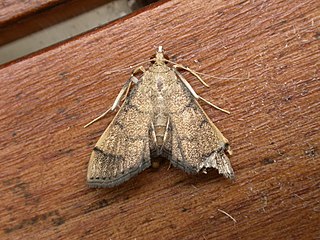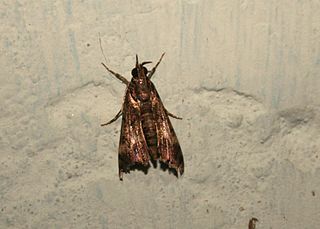Related Research Articles

Omiodes is a moth genus in the family Crambidae. Several species are endemic to Hawaii.

Lantanophaga pusillidactyla, the lantana plume moth, is a moth of the family Pterophoridae. It is native to the southern United States, Mexico, the Caribbean and South America. It was introduced to Australia accidentally in 1936 and is now found from Sydney to Cairns along the coast. It has also been introduced to Hawaii in 1902, Pohnpei in 1948 and Palau in 1960 for biological control. It has since been recorded from Yap in 1987–1988 and is now distributed on all islands of the Mariana and Caroline Islands where the host plant is found, except Aguijan.

Achyra massalis, the ombava, is a moth of the family Crambidae. The species was described by Francis Walker in 1859. It is found in most of the Old World tropics, including Réunion, Namibia and Australia.

Glyphodes negatalis, the karanj defoliator, is a moth of the family Crambidae. The species was first described by Francis Walker in 1859. It has a wide range in the tropics, including South Africa, The Gambia, Mali, India, Sri Lanka, Hong Kong, Japan and eastern Australia.

Bradina admixtalis is a species of moth of the family Crambidae described by Francis Walker in 1859. It is found in Australia, New Guinea, New Zealand, south-east Asia and the Comoros, Réunion, South Africa as well as India.

Omiodes indicata, the bean-leaf webworm moth or soybean leaf folder, is a species of moth of the family Crambidae. It is found from Florida to Texas, the West Indies and Mexico to South America, Cameroon, the Comoros, the Democratic Republic of Congo, La Réunion, Madagascar, Mauritius, Nigeria, Saudi Arabia, the Seychelles, South Africa, India, Borneo and Australia (Queensland).

Noorda blitealis is a species of moth of the family Crambidae. It is found in subtropical Africa, south of the Sahara and in Australasia.
Rhipidarctia invaria is a moth in the family Erebidae. It was described by Francis Walker in 1856. It is found in Angola, Cameroon, the Republic of the Congo, the Democratic Republic of the Congo, Gabon, Ivory Coast, Nigeria, Sierra Leone, Tanzania and Uganda.
Achyra coelatalis is a moth in the family Crambidae. It was described by Francis Walker in 1859. It is found in Botswana, the Democratic Republic of the Congo, Ghana, Kenya, Réunion, Lesotho, Madagascar, Namibia, Niger, the Seychelles, South Africa, Tanzania, Zambia, Zimbabwe, Australia, India and Sri Lanka.
Palpita elealis is a moth in the family Crambidae. It was described by Francis Walker in 1859. It is found in Cameroon, the Republic of the Congo, the Democratic Republic of the Congo, Ghana, Ivory Coast, Sierra Leone, South Africa, São Tomé and Príncipe, the Gambia, Zambia and Zimbabwe.
Ghesquierellana hirtusalis is a moth in the family Crambidae. It was described by Francis Walker in 1859. It is found on the Comoros (Mohéli) and in the Democratic Republic of the Congo, Ethiopia, Réunion, Madagascar, Sierra Leone, South Africa, Zimbabwe, and Mali.

Glyphodes pyloalis, the lesser mulberry snout moth, lesser mulberry pyralid or beautiful glyphodes moth, is a moth in the family Crambidae. It was described by Francis Walker in 1859. It is found in Iran, China, Japan, India, Indonesia (Sumatra), Sri Lanka, Taiwan, the Democratic Republic of the Congo, Equatorial Guinea, Mozambique and North America, where it has been recorded from Florida, Maryland, North Carolina, South Carolina and Virginia.

Nacoleia charesalis is a moth in the family Crambidae. It was described by Francis Walker in 1859. It is found in Australia, India, Sri Lanka, Borneo, Sumbawa, the Philippines, Singapore, Thailand, Japan, Taiwan and on the Seychelles.
Herpetogramma stultalis is a moth in the family Crambidae. It was described by Francis Walker in 1859. It is found in Malaysia, India, Sri Lanka, China, Japan, Pakistan, Papua New Guinea and Australia, where it has been recorded from Queensland. In Africa, it has been recorded from the Democratic Republic of the Congo and Réunion.
Notarcha obrinusalis is a moth in the family Crambidae. It was described by Francis Walker in 1859. It is found in Democratic Republic of the Congo, Zambia, China, India and Indonesia.
Omiodes surrectalis is a moth in the family Crambidae. Described by Francis Walker in 1866, it is found in the Democratic Republic of the Congo, India, Indonesia, the Philippines, Sri Lanka, New Guinea and Queensland, Australia.
Pardomima amyntusalis is a moth in the family Crambidae. It was described by Francis Walker in 1859. It is found in the Democratic Republic of the Congo, Ivory Coast, Kenya, Madagascar, Mozambique, Sierra Leone, Uganda, Zambia, Sri Lanka, India, Indonesia (Java), Myanmar and Australia, where it has been recorded from Western Australia.

Patania sabinusalis is a moth in the family Crambidae. It was described by Francis Walker in 1859. It is found in Cameroon, the Democratic Republic of the Congo, Kenya, the Seychelles, Somalia, Uganda, Zambia, Sri Lanka, India, Borneo, Java, Fiji, the Solomon Islands, Taiwan and Japan.

Pycnarmon meritalis is a moth in the family Crambidae. It was described by Francis Walker in 1859. It is found in Democratic Republic of the Congo, South Africa, Australia, China, Sri Lanka, India, Indonesia, Taiwan and Japan.

Aproaerema simplexella, the soybean moth, is a moth in the family Gelechiidae. It was described by Francis Walker in 1864. It is found in India, China, Australia, Norfolk Island and New Zealand. It is an invasive species in Africa, where it has since been recorded from the Democratic Republic of the Congo, Malawi, South Africa and Uganda.
References
- ↑ Nuss, M.; et al. (2003–2014). "GlobIZ search". Global Information System on Pyraloidea. Retrieved 2014-07-15.
- ↑ De Prins, J. & De Prins, W. (2017). "Omiodes poeonalis (Walker, 1859)". Afromoths. Retrieved January 30, 2018.
- ↑ Lepidoptera Larvae of Australia
- ↑ African Moths
| This Omiodes-related article is a stub. You can help Wikipedia by expanding it. |